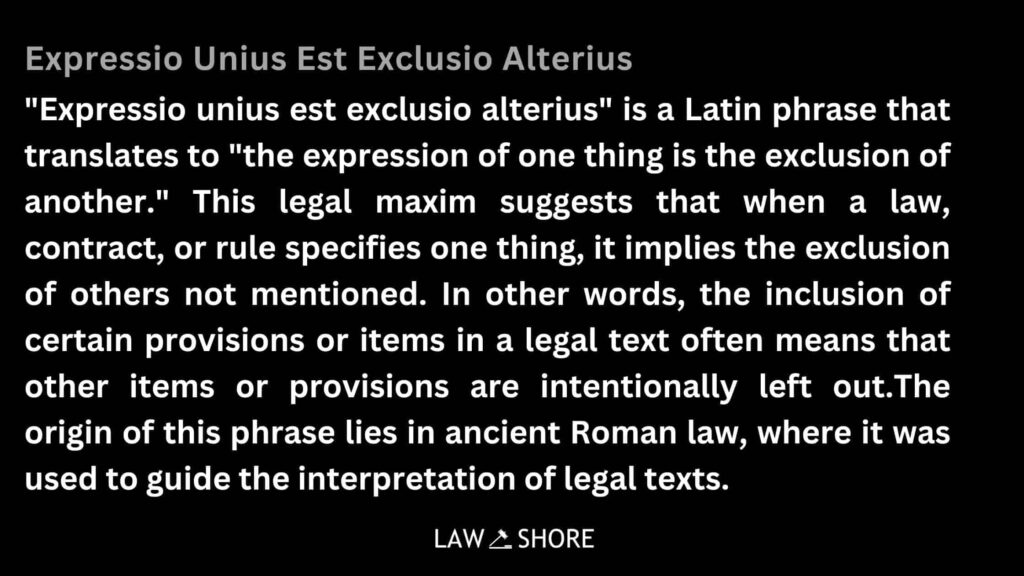Meaning and Origin of Expressio Unius Est Exclusio Alterius
Table of Contents
Toggle“Expressio unius est exclusio alterius” is a Latin phrase that translates to “the expression of one thing is the exclusion of another.” This legal maxim suggests that when a law, contract, or rule specifies one thing, it implies the exclusion of others not mentioned. In other words, the inclusion of certain provisions or items in a legal text often means that other items or provisions are intentionally left out.
The origin of this phrase lies in ancient Roman law, where it was used to guide the interpretation of legal texts. It remains an essential principle in common law, civil law systems, and statutory interpretation, as it provides a simple method to determine legislative intent.

Key Features of Expressio Unius Est Exclusio Alterius
- Inclusion Implies Exclusion: The most fundamental feature of this maxim is the principle that specifying one thing implies that other unmentioned things are not included. For example, if a law states that “only citizens are entitled to vote,” it excludes non-citizens from voting rights by the mere mention of “citizens.”
- Literal Interpretation: The application of this principle typically follows a literal approach to interpretation. Courts may interpret the language of statutes strictly according to its wording, and if something is specifically named, then everything not named is considered excluded.
- Relevance to Statutory Construction: In legal proceedings, this maxim helps courts construe statutes, contracts, or regulations. If a statute mentions particular items, and does not refer to others, a judge might conclude that the excluded items are not covered under the statute.
- Limitations and Context Dependence: While “expressio unius est exclusio alterius” serves as a useful tool in legal interpretation, it is not absolute. Courts often rely on the specific context, legislative intent, and overall purpose of a statute to determine whether the exclusion of unmentioned items is warranted.
Application in India
In India, “expressio unius est exclusio alterius” plays a significant role in the interpretation of statutes, constitutional provisions, and legal contracts. Indian courts regularly employ this principle to resolve ambiguities in laws and regulations.
- Constitutional and Statutory Interpretation: Indian courts frequently apply the maxim to interpret both statutory laws and the Constitution. For instance, in cases of fundamental rights or property laws, if a law specifically mentions one category of persons or activities, it may exclude others from enjoying the benefits or being subject to the provisions of that law.
- Judicial Precedents: The Indian judiciary has often applied the principle of “expressio unius est exclusio alterius” in its judgments. In State of Haryana v. Bhajan Lal (1992), the Supreme Court applied this principle while interpreting the scope of a provision to limit the scope of powers granted under a specific rule.
- Contractual Law: In contractual matters, Indian courts interpret agreements and contracts by applying this principle to determine the scope of rights and duties of the parties involved. The mention of certain rights, obligations, or conditions in a contract can exclude any other rights or obligations that are not specifically listed.
- Exceptions and Limits: Indian courts are mindful that this principle is not always rigid. Judges often consider the legislative intent and the spirit of the law. For example, if the legislature intended to include a wider scope of subjects, the principle of exclusion may not apply, especially where the context demands a broader or more inclusive interpretation.
Limitations of Expressio Unius Est Exclusio Alterius
While the maxim is a valuable tool in statutory interpretation, its application is not absolute. Courts have long recognized that the principle can lead to unjust results if applied too strictly. Below are some limitations:
- Ambiguity in Legislative Intent: The intent of lawmakers is often subject to interpretation. If the law or rule was poorly drafted or does not clearly express intent, applying this maxim could distort its purpose.
- Flexibility of Interpretation: Many modern courts, especially in India, allow for a more flexible approach. Courts look beyond the literal wording of the statute to determine the overall purpose and intent behind it. The legislative context and broader principles of justice may override a strict application of the maxim.
- Exclusion May Not Be Intentional: Sometimes, a provision might not list all relevant items not because of exclusion but because the list is intended to be non-exhaustive or to focus on the most pressing issues. As such, the mention of one element doesn’t always mean the exclusion of all others.
- Other Principles of Interpretation: Other maxims and principles of interpretation may take precedence over “expressio unius est exclusio alterius,” including the principle of ejusdem generis (the rule of interpreting general words in light of specific ones), and purposive interpretation, which considers the broader purpose of the statute.
Case Law and Judicial Precedents
In the Indian legal system, the maxim has been referenced in numerous judgments. In State of West Bengal v. Subodh Gopal Bose (1954), the Supreme Court of India used this principle to interpret a law about the rights of particular categories of employees.
However, there are instances where the courts have rejected a rigid application of this principle, citing a need for a broader understanding of the law or referring to the law’s purpose. In cases where “expressio unius est exclusio alterius” would lead to an unjust or overly narrow interpretation, courts may prefer to adopt a purposive approach to align with legislative intent.
Conclusion
“Expressio unius est exclusio alterius” remains a cornerstone of legal interpretation, guiding courts in determining legislative intent and the scope of legal provisions. While it is a useful tool in understanding statutes, the principle is not without its limitations. In India, like in other jurisdictions, courts balance this maxim with the broader context of the law, often applying it flexibly to ensure that justice is served and legislative intent is fully respected.
Explore Law Shore: law notes today and take the first step toward mastering the fundamentals of law with ease.

After Completing my LLB hons, I started writing content about legal concepts and case laws while practicing. I finally started Law Shore in 2024 with an aim to help other students and lawyers.


